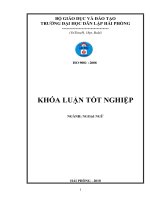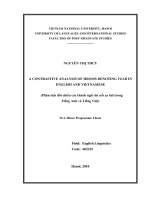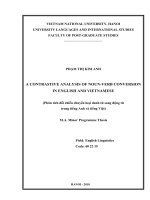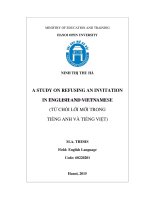A COMPARITIVE STUDY ON INTERNET SLANGS USED IN ENGLISH AND VIETNAMESE
Bạn đang xem bản rút gọn của tài liệu. Xem và tải ngay bản đầy đủ của tài liệu tại đây (595.09 KB, 56 trang )
BỘ GIÁO DỤC VÀ ĐÀO TẠO
TRƯỜNG ĐẠI HỌC DÂN LẬP HẢI PHỊNG
------------------------------(VnTimeH, 18pt, Bold)
ISO 9001 : 2008
KHĨA LUẬN TỐT NGHIỆP
NGÀNH: NGOẠI NGỮ
HẢI PHÒNG - 2010
1
HAIPHONG PRIVATE UNIVESITY
FOREIGN LANGUAGES DEPARTMENT
-----------------------------------
GRADUATION PAPER
A COMPARITIVE STUDY ON INTERNET SLANGS
USED IN ENGLISH AND VIETNAMESE
By:
NGUYEN THI HOA TRANG
Class:
NA1004
Supervisor:
NGUYEN THI THUY THU, M.A
HAI PHONG - 2010
2
BỘ GIÁO DỤC VÀ ĐÀO TẠO
TRƯỜNG ĐẠI HỌC DÂN LẬP HẢI PHÒNG
--------------------------------------
Nhiệm vụ đề tài tốt nghiệp
Sinh viên :............................................................Mãsố:............................
Lớp:.............................Ngành:....................................................................
Tên đề tài: .................................................................................................
..................................................................................................
.................................................................................................
..................................................................................................
3
Nhiệm vụ đề tài
1. Nội dung và các yêu cầu cần giải quyết trong nhiệm vụ đề tài tốt
nghiệp
( về lý luận, thực tiễn, các số liệu cần tính tốn và các bản vẽ).
……………………………………………………………………………..
……………………………………………………………………………..
……………………………………………………………………………..
……………………………………………………………………………..
……………………………………………………………………………..
……………………………………………………………………………..
……………………………………………………………………………..
……………………………………………………………………………..
2. Các số liệu cần thiết để thiết kế, tính tốn.
……………………………………………………………………………..
……………………………………………………………………………..
……………………………………………………………………………..
……………………………………………………………………………..
……………………………………………………………………………..
……………………………………………………………………………..
……………………………………………………………………………..
……………………………………………………………………………..
……………………………………………………………………………..
3. Địa điểm thực tập tốt nghiệp.
……………………………………………………………………………..
……………………………………………………………………………..
……………………………………………………………………………..
4
CÁN BỘ HƯỚNG DẪN ĐỀ TÀI
Người hướng dẫn thứ nhất:
Họ và tên: .............................................................................................
Học hàm, học vị: ...................................................................................
Cơ quan công tác:.................................................................................
Nội dung hướng dẫn:............................................................................
Người hướng dẫn thứ hai:
Họ và tên:.............................................................................................
Học hàm, học vị:...................................................................................
Cơ quan công tác:.................................................................................
Nội dung hướng dẫn:............................................................................
Đề tài tốt nghiệp được giao ngày 12 tháng 04 năm 2010
Yêu cầu phải hoàn thành xong trước ngày 10 tháng 07 năm 2010
Đã nhận nhiệm vụ ĐTTN
Đã giao nhiệm vụ ĐTTN
Người hướng dẫn
Sinh viên
Hải Phòng, ngày tháng năm 2010
HIỆU TRƯỞNG
GS.TS.NGƯT Trần Hữu Nghị
5
PHẦN NHẬN XÉT TÓM TẮT CỦA CÁN BỘ HƯỚNG DẪN
1. Tinh thần thái độ của sinh viên trong quá trình làm đề tài tốt
nghiệp:
……………………………………………………………………………..
……………………………………………………………………………..
……………………………………………………………………………..
……………………………………………………………………………..
……………………………………………………………………………..
……………………………………………………………………………..
……………………………………………………………………………..
……………………………………………………………………………..
2. Đánh giá chất lượng của khóa luận (so với nội dung yêu cầu đã đề ra
trong nhiệm vụ Đ.T. T.N trên các mặt lý luận, thực tiễn, tính tốn số
liệu…):
……………………………………………………………………………..
……………………………………………………………………………..
……………………………………………………………………………..
……………………………………………………………………………..
……………………………………………………………………………..
……………………………………………………………………………..
……………………………………………………………………………..
……………………………………………………………………………..
……………………………………………………………………………..
3. Cho điểm của cán bộ hướng dẫn (ghi bằng cả số và chữ):
……………………………………………………………………………..
……………………………………………………………………………..
……………………………………………………………………………..
Hải Phòng, ngày ….. tháng ..… năm 2010
Cán bộ hướng dẫn
(họ tên và chữ ký)
6
NHẬN XÉT ĐÁNH GIÁ
CỦA NGƯỜI CHẤM PHẢN BIỆN ĐỀ TÀI TỐT NGHIỆP
1. Đánh giá chất lượng đề tài tốt nghiệp về các mặt thu thập và phân tích tài
liệu, số liệu ban đầu, giá trị lí luận và thực tiễn của đề tài.
2. Cho điểm của người chấm phản biện :
(Điểm ghi bằng số và chữ)
Ngày.......... tháng......... năm 2010
Người chấm phản biện
7
TABLE OF CONTENTS
Acknowledgment
PART I: INTRODUCTION
1. Rationale of the study
2. Aim of the study
3. Scope of the study
4. Method of the study
5. Design of the study
PART II: DEVELOPMENT
Chapter one: Theoretical background
1. Nonstandard words
1.1.
Slangs
1.1.1. General slangs
1.1.2. Special slangs
1.2.
Vulgar words (vulgarisms)
1.3.
Dialectal words
2. The distinction between slangs and colloquialism
3. Internet slangs
3.1.
Definition
3.2.
The origin
3.3.
Sources of internet slang
3.3.1. Chat rooms
3.3.2. Forums and Facebook
3.3.3. Private Blog
Chapter two: Types of Internet slangs
1. Acronym and abbreviation
2. Single letter words and numbers
3. Characters
8
4. Speech deduction
5. ―L33t‖ speech
6. Rhyming slangs
Chapter three: Comparison between English Internet slangs and Vietnamese
ones
1. Base on function of Internet slangs
1.1.
Similarities
1.2.
Differences
2. Base on classification of Internet slangs
PART III: CONCLUSION
1. Vietnamese Teenagers are abusing Internet slangs
2. Are you learning Internet slangs?
3. Parents should know about Internet slangs
REFERENCES
APPENDIX 1
APPENDIX 2
APPENDIX 3
9
INTRODUCTION
I. Rationale
Internet is a global system of inter - connected computer networks that
use the standardized Internet Protocol Suite to serve billions of users
worldwide. Internet today has become no longer strange to people in modern
life. Everyone accesses to the Internet to search information, to use services or
entertainment or perhaps to do business. Now it seems to become an integral
part of our lives.
Along with the developments of technology, Internet has made more
and more changes. Internet slangs terms were developed by users over the
years. Internet slangs is what Internet users have coined and promulgated and
now has become popular in many websites, chat rooms, bogs or forums.
Internet slangs is a very casual speech in writing that uses certain words,
phrases or expressions in the form of abbreviations to convey a message
which may be vivid and concise, sarcastic, racy, humorous or even vulgar in
meaning. Internet slangs consist of words formed from the initial letter or
letters of a series of words in a phrase. Such terms typically originated with
the purpose of saving keystrokes and many people use the same abbreviation
in text messages, some believes that using this language is stylish. As the
Internet has grown new acronyms and slang words seem to be made
everyday, and keeping up with them can be confusing. Have you ever
confused when you saw on the websites or blogs some slangs? Have you ever
felt shocked to see a multitude of symbols or odd characters? Those lead to
my decision on studying Internet slangs to find out the similarities and
differences between English and Vietnamese ones.
10
II. Aim of the study
The research paper:
Aims at understanding more about Internet slangs used by teenagers to
reduce confusion, troubles when they encountered.
Learning more about the diversity of language.
III. Scope of the study
Due to the time limitation, resources and my knowledge, this research
paper only focuses on Internet slangs used by teenagers especially by 9X
Teens in some common websites, blogs, chat rooms or forums. For my
purposes, I will focus on an intersection of those adolescent years and the
teenage years, generally defined as ages 13-19.
IV. Method of the study
The method of this study is:
The comparative and contrastive analysis to distinguish similarities and
differences between two languages;
Consultation with the supervisor;
Material collection: to collect internet slangs on the common websites,
blogs, chatting rooms or Internet forums and some basic slangs‘
dictionaries.
V. Design of study
This study consists of three parts:
Part I: Introduction, which states the reasons of the study, the aims of the
study, the scope of the study, the methods of the study and the design of the
study.
Part II: Development: The main content including three chapters:
The first chapter presents the theoretical background. It focuses on
some general definition of non-standard words, origin and source of Internet
11
slangs.
The second chapter presents types of English Internet slangs.
The third chapter states the comparison between English and Vietnamese
Internet slangs with their function, usages and classification to find the
similarities and differences.
Part III: Conclusion of the whole study which summarizes the topic and states
some troubles and recommendations for Internet slang users.
12
DEVELOPMENT
Chapter one: Theoretical Background
The stylistic aspect of the English vocabulary is varied. English words
may be classified in different ways. The following diagram illustrates (H
Basic (Hoang Tat Truong, Basic English Lexicology)
English Words
Non standard
Standard
Neutral
Slangs
Vulgar
Dialectal
Colloquial
General
Special
Bookish
Poeticarchaic
1.
General
Scientific
Non assimilated
Non-standard words
Non-standard words are chiefly used in spoken English thus being
considered as non-standard colloquialisms. Non-standard vocabulary of
extreme informality, usually not limited to any region. It includes newly
coined words, shortened forms, and standard words used playfully out of their
usual contexts. These are subdivided into:
13
Slangs
Vulgar words
Dialectal words
1.1.
Slangs
Slangs are the use of informal words and expressions that are not
considered standard in the speaker's dialect or language. Slangs are often
found in areas of the lexicon that refer to things considered taboo (see
euphemism). It is also used to identify with one's peers.
( />Few linguists have endeavored to clearly define what constitutes
slangs. Attempting to remedy this, Bethany K. Dumas and Jonathan Lighter
argue that an expression should be considered "true slangs" if it meets at least
two of the following criteria:
+ It lowers, if temporarily, "the dignity of formal or serious speech or
writing"; in other words, it is likely to be seen in such contexts as a "glaring
misuse of register"
+ Its use implies that the user is familiar with whatever is referred to, or
with a group of people who are familiar with it and use the term.
14
+ It is a taboo term in ordinary discourse with people of a higher social
status or greater responsibility.
+ It replaces "a well-known conventional synonym". This is done
primarily to avoid the discomfort caused by the conventional item or by
further elaboration.
Additionally, Bethany. K. Dumas and Jonathan Lighter
(1978) defined: “Slangs are a set of highly informal words and expressions
that are not considered standard in the speaker's dialect or language. Slangs
are often highly regional, specific to a particular territory or subculture.
Slang words and expressions can spread outside their original arena, and
some may even lose their slang status and become accepted as a standard
language. Often, the widespread adoption of a slangs term by mainstream
culture will cause the subculture it originated in to create a new, less
recognized term.”
Slangs often convey an acerbic, even offensive, no-nonsense attitude
and lend it- self to poking fun at pretentiousness. Frequently grotesque and
fantastic, it is usually spoken with intent to produce a startling or original
effect. It is especially well developed in speaking vocabularies of cultured,
sophisticated, linguistically rich languages.
Slangs consist of the words and expressions that have escaped from the
cant, Jargon and argot (and to a lesser extent from dialectal, nonstandard, and
taboo speech) of specific subgroups of society so that they are known and
used by an appreciable percentage of the general population, even though the
words and expressions often retain some associations with the subgroups that
originally used and popularized them. Thus, slangs is a middle ground for
words and expressions that have become too popular to be any longer
considered as part of the more restricted categories, but that are not yet (and
may never become) acceptable or popular enough to be considered informal
or standard. (Compare the slangs "hooker" and the standard "prostitute".)
15
Slangs tend to originate in subcultures within a society. Occupational
groups (for example, loggers, police, medical professionals, and computer
specialists) are prominent originators of both jargon and slangs; other groups
creating slangs include the armed forces, teenagers, racial minorities, ghetto
residents, labor unions, citizens- band radiobroadcasters, sports groups, drug
addicts, criminals, and even religious denominations (Episcopalians, for
example, produced spike, a High Church Anglican). Slangs expressions often
embody attitudes and values of group members. They may thus contribute to
a sense of group identity and may convey to the listener information about the
speaker‘s background. Before an apt expression becomes slangs, however, it
must be widely adopted by members of the subculture. At this point slangs
and jargon overlap greatly. If the subculture has enough contact with the
mainstream culture, its figures of speech become slangs expressions known to
the whole society. For example, cat (a sport), cool (aloof, stylish), Mr.
Charley (a white man), The Man (the law), and Uncle Tom (a meek black) all
originated in the predominantly black Harlem district of New York City and
have traveled far since their inception. Slangs are thus generally not tied to
any geographic region within a country.
( />1.1.1. General slangs: used by all people but considered as sub – standard
(non – standard) due to excessive informality.
For example: dough (money); mug (face); cop (police man)…
1.1.2. Special slangs: also called jargon of which the words and expressions
are called jargonisms. Special slangs are used within some social or
professional group and understandable to the members of these groups only.
There are school slangs, military slangs, political slangs and so forth:
“Belly- robber” (cook – military slangs)
“To take for a ride” (to kill – criminal slangs)
16
It is also interesting to note that slangs in general may be case of phonetic
distortion:
"Cuppa” (cup of tea); lotta (lots of)
1.2. Vulgar words (vulgarisms)
Vulgar words are ―dirty‖ words used by few people. They are not
generally used in public. For example:
“Dammed”: “It’s dammed hot today!”
“Bloody”: “The shirt is bloody expensive”
Vulgarisms express anger, annoyance, disagreement and other strong
emotions. Because of high frequency of usage, the examples above are getting
less vulgar, less ―dirty‖ and often heard among friends, students etc.
(According to Basic English Lexicology)
1.3. Dialectal words: belong to only a definite territory or locality.
For example: “Loch” (Scottish) = “lake”
Dialectal words are also called dialectisms.
2. The distinction between slangs and colloquialisms
Some linguists make a distinction between slangisms (slangs words)
and colloquialisms. According to Ghil'ad Zuckerman, "slangs refer to
informal (and often transient) lexical items used by a specific social group, for
instance teenagers, soldiers, prisoners and thieves. Slangs are not the same as
colloquial (speech), which is informal, relaxed speech used on occasion by
any speaker; this might include contractions such as 'you‘re,' as well as
colloquialisms.
A colloquialism is a lexical item used in informal speech; while the
broadest sense of the term ‗colloquialism‘ might include slangisms, its
narrow sense does not.
17
Slangisms are often used in colloquial speech but not all
colloquialisms are slangisms. One method of distinguishing between
slangism and a colloquialism is to ask whether most native speakers know the
word (and use it); if they do, it is a colloquialism. However, the problem is
that this is not a discrete, quantized system but a continuum.
3. Internet slangs
3.1. Definition
Internet slangs (Internet language, Internet Short-hand, l33t, net speak
or chat- speak) is a type of slangs that Internet users have popularized, and in
many cases, have coined. Such terms often originate with the purpose of
saving keystrokes. It consists of such as word, phrase word, numbers or
symbols which Internet users often use on some websites, chat room, blogs or
forums…
(http:en.wikipedia.org/wiki/Internet-slang)
18
For example:
BF: Boyfriend
G9: Goodnight
U: You
Internet slangs are commonly used in websites that have online
communities.
For example:
rofl, thats so funny lmao! (Rolling on floor laughing, that’s so funny laughing
my ass off!)
3.2. The origins of Internet slang
The vocabulary of Internet slangs draws from many different sources typically environments that placed value on brevity of communication.
Chat acronyms originally developed on pre-Internet bulletin board systems.
The three-letter acronym remains one of the most popular types of
abbreviation in computing and telecom terminology and slangs.
In the '50s the birth of rock and roll, the Beat Generation and the
increasing influence of American culture in films, TV and music saw the
introduction phrases like 'cool' (tuyệt vời), 'hip' (hoan hô) and 'nerd' (người
điên, dở).
In the swinging '60s it was the hippies, the protest generation, the
emerging drug culture and the cool cats of Carnaby Street. 'Groovy' (tuyệt
vời), 'far out', (tuyệt vời), 'dig' (thích, cảm kích), 'cat' (xù xì, xấu) and 'dude'
(cơng tử) were among the more popular words of the time.
In the '70s funk, punk, glam rock and disco all influenced slangs,
phrases like 'boogie' (nhảy theo nhạc POP hoặc nhạc ROCK), 'funky' (nhạc
mạnh), 'bad (tuyệt vời)', 'bitchin' (tuyệt vời), 'wicked’ (tuyệt vời) and 'dope'
(tuyệt vời).
19
In the '80s the words and phrases from American hip-hop culture
started to infiltrate British youth language, many of which can still be heard
today, with words like 'da' as in 'he's da man (người đàn ơng có búi tóc)',
'diss' (coi thường), 'booty (đồ ăn cắp được)', 'bling' (châu báu, đồ nữ trang).
Of course there are plenty of slangs words used by British teens that come
from within our own culture.
Today, the Internet and texting has an impact on the way teenagers
speak and write and there has been an emergence of abbreviated words that
infuriate teachers and have most adults scratching their heads. 'Book' now
means 'cool', because if you type 'cool' in predictive text it first brings up
'book' and there are a multitude of abbreviations such as LOL (laugh out
loud) and BRB (be right back) that are common place on Instant Messenger
and e-mails.
There are various Internet slangs on forums, in chat rooms, emails,
blogs and instant message which use acronyms and some fancy abbreviations
to bring across certain messages. Internet slangs is a very casual speech in
writing that uses certain words, phrases or expressions in the form of
abbreviations and characters to convey a message which may be vivid and
concise, sarcastic, racy, humorous or even vulgar in meaning. Internet slangs
consist of words formed from the initial letter or letters of a series of words in
a phrase. This means it is an abbreviation of the first letters of a phrase or a
long phrase that may form a word which may also convey a message.
However, most of the Internet slangs are not actually acronyms since they do
not form a word which can be pronounced phrases that helps one to keep their
message concise and to the point.
3.3. Source of Internet slangs
3.3.1. Chat rooms: This is an Internet place where people gather to gather
all at the same time to talk to one another using the computer. Often it is
just a web page, like any other, and everyone is using an additional
20









